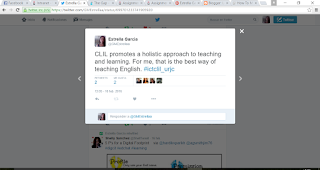Hello everybody!
I have made my current PLE and PLN for CLIL. First of all, I want to say that I didn’t know much about CLIL before starting this Master in Bilingual Education. I knew that some subjects are currently taught in English in Bilingual schools but I didn’t understand very well how, when and why. However, I think that the learning process and the discovering that we all are doing help us much to know new things.

I created my diagram with Easelly http://www.easel.ly/create?id=https://s3.amazonaws.com/easel.ly/all_easels/1488523/1455975180&key=pri .
I usually use a wordle creator to do online spider diagrams but I feel that tool is less sophisticated than Easelly and we don’t have the possibility of including arrows to connect words. Because of thaose reasons finally, I have tried a new one that is Easelly as I have mentioned above. I like this tool because it lets us choose so many options. During or after using it, we have an option that is to download our diagram in a PDF document too, so we can save it and have a look at it without internet connection.
I have distributed my diagram in two big sections that are interrelated:
My PLE (Personal Learning Environment) that it is based on the searching that I do to know more about CLIL. I want to highlight the following sites:
- TEDtalks: I use it to watch fascinating short videos about a huge variety of topics.
- TES: I use it to find resources that can be applied in a CLIL class.
- Digital newspapers and magazines: I listen to interviews or read interesting articles, news, etc. about CLIL.
- Google: That is one of my favourites, with a simple click I can find relevant information. I can read and investigate all the new CLIL aspects and theories.
- Word Reference: I use it when I am reading something about CLIL and I am not very sure about the meaning of a word or concept.
- YouTube: I use it to find audiovisual information about whatever.
- Blogger: I enjoy reading blogs and find other points of view, materials, resources, data, etc.
- Pinterest: I use it when I want to find practical ideas, resources, etc. for lesson plans.
Having explained my PLE, now I am going to point out my PLN (Personal Learning Network). In this section I have included the following ideas:
- Moddle: I use it to exchange personal information with my partners.
- Twitter and Facebook: I use these social networks to read about CLIL and to share my knowledge about it.
- Gmail and Dropbox: I share and post information about CLIL lesson plans, activities, information and more. It's the perfect place to organize my staff online.
- Whatsapp and forums: I use it to exchange opinions and discussions.
That is my present PLE and PLN for CLIL, Perhaps you want to help me continue working on it. Please, don't hesitate to contact me. I am looking forward to hearing from you!!




